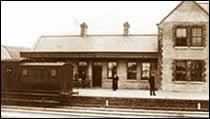
MGWR was provided with a government grant of £264,000
to build a line from Galway across Connemara to Clifden. The intention had
been to improve communications with a developing fishing industry and the
MGWR engineers designed a route to follow the coastline, where the population
was estimated to be around 60,000 persons. However, the Royal Commission
on Public Works thought otherwise and directed that an inland route should
be followed via Oughterard. Largely as a result of this decision, freight
traffic failed to materialise, and the railway company chose instead to
develop the tourism potential of the area.
The line was opened to Clifden on 1st of July 1895 and cost £432,000,
or £9,000 per mile. Altogether, there were some 30 bridges, including
an imposing steel viaduct, which crossed the River Corrib in Galway. Today
only the piers remain of the viaduct, the three spans of which were 150
ft, with a bascule type lifting navigation span of 21 ft. (6.3)
The engineers for the railway were John Henry Ryan and
Edward Townsend. A paper entitled " The Galway And Clifden Railway"
by J. H. Ryan, Vice-President, Institution of Civil Engineers of Ireland,
is recorded in the Institution's transactions of 1901. The line was closed
in April 1935.
|

Achill Railway Station 1911

In late 1890, Robert Worthington, the main
contractor to the MGWR, began work on the line between Westport and Mullranny
and this was later extended to Achill.
The town of Newport is on the Newport river,
where it flows into the north-east corner of Clew Bay. At Newport the single
line track crossed the river on a fine viaduct of red sandstone.
The overall length of the viaduct is 305ft (92m) and the width 18ft 6in.
The line was not opened until 1894 on completion of a nearby tunnel.
The viaduct is now a pedestrian route and,
together with the adjacent road bridge, forms an attractive backdrop to
the town, especially when floodlit at night. Like the Clifden railway this
branch line was similarly closed in 1935. |

